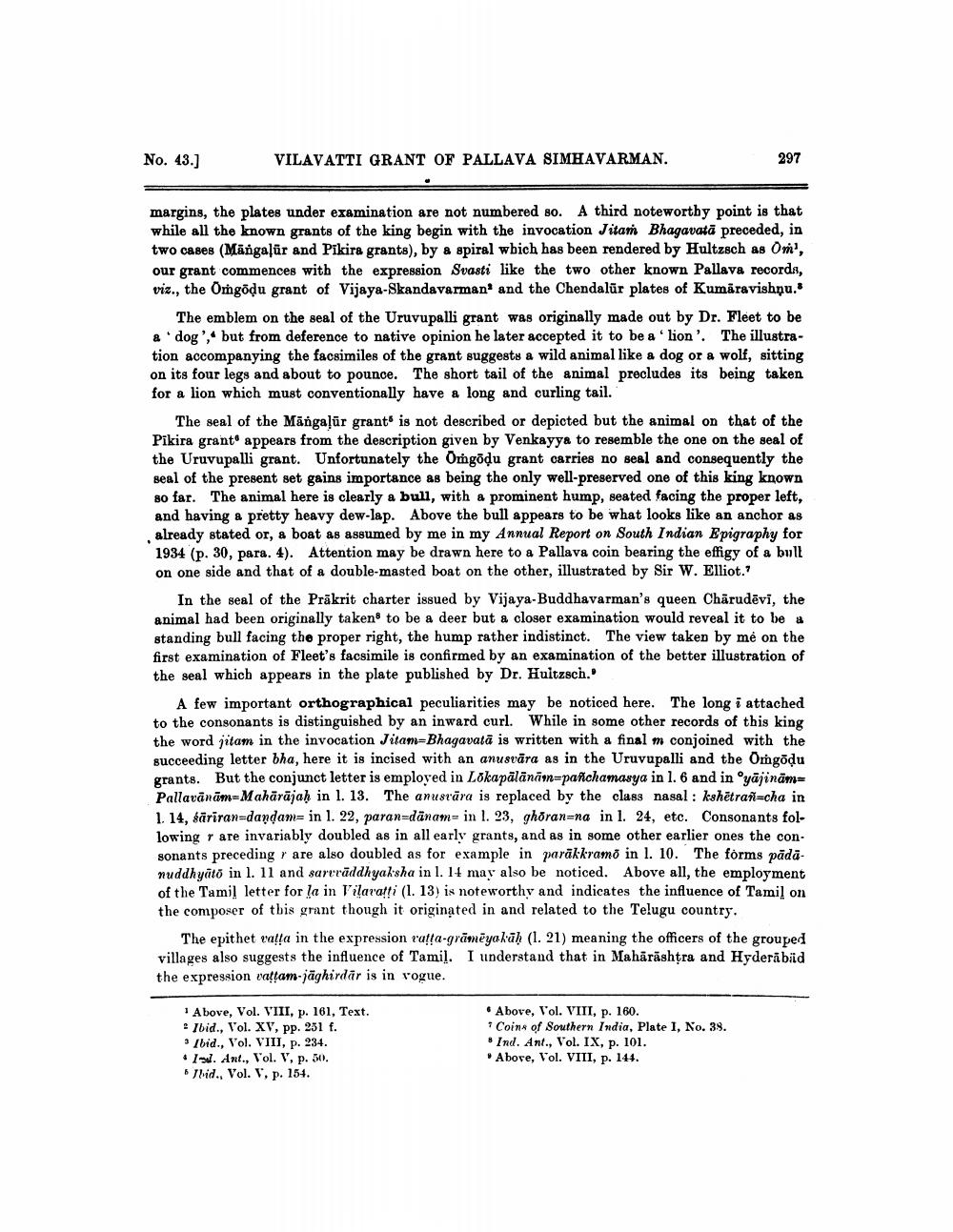________________
No. 43.]
VILAVATTI GRANT OF PALLAVA SIMHAVARMAN.
margins, the plates under examination are not numbered so. A third noteworthy point is that while all the known grants of the king begin with the invocation Jitam Bhagavata preceded, in two cases (Mangalür and Pikira grants), by a spiral which has been rendered by Hultzsch as Om', our grant commences with the expression Svasti like the two other known Pallava records, viz., the Omgōḍu grant of Vijaya-Skandavarman' and the Chendalur plates of Kumāravishņu.
297
The emblem on the seal of the Uruvupalli grant was originally made out by Dr. Fleet to be a dog', but from deference to native opinion he later accepted it to be a 'lion'. The illustration accompanying the facsimiles of the grant suggests a wild animal like a dog or a wolf, sitting on its four legs and about to pounce. The short tail of the animal precludes its being taken for a lion which must conventionally have a long and curling tail.
The seal of the Mangalur grant is not described or depicted but the animal on that of the Pikira grant appears from the description given by Venkayya to resemble the one on the seal of the Uruvupalli grant. Unfortunately the Omgōḍu grant carries no seal and consequently the seal of the present set gains importance as being the only well-preserved one of this king known so far. The animal here is clearly a bull, with a prominent hump, seated facing the proper left, and having a pretty heavy dew-lap. Above the bull appears to be what looks like an anchor as already stated or, a boat as assumed by me in my Annual Report on South Indian Epigraphy for 1934 (p. 30, para. 4). Attention may be drawn here to a Pallava coin bearing the effigy of a bull on one side and that of a double-masted boat on the other, illustrated by Sir W. Elliot."
In the seal of the Prakrit charter issued by Vijaya-Buddhavarman's queen Charudēvi, the animal had been originally taken to be a deer but a closer examination would reveal it to be a standing bull facing the proper right, the hump rather indistinct. The view taken by me on the first examination of Fleet's facsimile is confirmed by an examination of the better illustration of the seal which appears in the plate published by Dr. Hultzsch.'
A few important orthographical peculiarities may be noticed here. The long i attached to the consonants is distinguished by an inward curl. While in some other records of this king the word jitam in the invocation Jitam-Bhagavata is written with a final m conjoined with the succeeding letter bha, here it is incised with an anusvāra as in the Uruvupalli and the Omgōḍu grants. But the conjunct letter is employed in Lõkapālānām-pañchamasya in 1. 6 and in oyājinām= Pallavānām-Mahārājaḥ in 1. 13. The anusrara is replaced by the class nasal: kshetrañ-cha in 1. 14, śāriran=daṇḍam in 1. 22, paran-dānam in l. 23, ghōran-na in l. 24, etc. Consonants following r are invariably doubled as in all early grants, and as in some other earlier ones the consonants preceding r are also doubled as for example in parakkramo in 1. 10. The forms pādānuddhyātō in 1. 11 and sarvräddhyaksha in 1. 14 may also be noticed. Above all, the employment of the Tamil letter for la in Vilavatti (1. 13) is noteworthy and indicates the influence of Tamil on the composer of this grant though it originated in and related to the Telugu country.
The epithet vaṭṭa in the expression ratta-grāmēyakāḥ (1. 21) meaning the officers of the grouped villages also suggests the influence of Tamil. I understand that in Maharashtra and Hyderabad the expression vaṭṭam-jāghirdär is in vogue.
Above, Vol. VIII, p. 161, Text. Ibid., Vol. XV, pp. 251 f.
3 Ibid., Vol. VIII, p. 234. I. Ant., Vol. V, p. 50. Ibid., Vol. V, p. 154.
Above, Vol. VIII, p. 160.
* Coins of Southern India, Plate I, No. 38. Ind. Ant., Vol. IX, p. 101. Above, Vol. VIII, p. 144.




